Heating cable for water pipes
Making the water supply of a private house or summer cottage constant and uninterrupted is not an easy task. The most difficult thing is to provide water supply in winter. To prevent the pipes from freezing, they can be laid below the freezing depth, but still there are weak points. The first is abnormally cold winters, which periodically break all records. The second is the place of entry into the house. They often freeze anyway. Exit - install a heating cable for the water supply. In this case, the sewage system is desirable, but it can be buried shallowly. And on the entry points into the house, you can lay a more powerful heater and better insulate it.
The content of the article
Types of heating cables for plumbing
There are two types of heating cables - resistive and self-regulating. In resistive ones, the property of metals is used to heat up when an electric current passes. A metal conductor is heated in heating cables of this type. Their characteristic feature is that they always emit the same amount of heat. It doesn't matter if it's + 3 ° C or -20 ° C outside, they will be heated the same way - at full power, therefore, they will consume the same amount of electricity. To reduce costs in a relatively warm time, temperature sensors and a thermostat are installed in the system (the same as used for an electric floor heating).
When laying, resistive heating wires should not intersect or be located next to each other (close to each other). In this case, they overheat and quickly fail. Pay close attention to this point during the installation process.
It should also be said that a resistive heating cable for a water supply system (and not only) can be single-core and two-core. Two-core ones are more often used, although they are more expensive. The difference is in the connection: for single-core ones, both ends must be connected to the mains, which is not always convenient. Two-core cables have a plug at one end, and a fixed ordinary electric cord with a plug, which is connected to a 220 V network, at the other. What else do you need to know? Resistive conductors cannot be cut - they will not work. If you bought a bay with a longer than necessary segment, lay it entirely.
Self-regulating cables are a metal-polymer matrix. In this system, the wires only conduct current, and the polymer is heated, which is located between the two conductors. This polymer has an interesting property - the higher its temperature, the less heat it emits, and vice versa, as it cools, it begins to release more heat. These changes occur regardless of the state of adjacent cable sections. So it turns out that he himself regulates his temperature, which is why he was called that - self-regulating.
Self-regulating (self-heating) cables have solid advantages:
- they can intersect and will not burn out;
- they can be cut (there are markings with cutting lines), but then you need to make an end sleeve.
They have one minus - a high price, but the service life (subject to the rules of operation) is about 10 years. So these expenses are reasonable.
Using a heating cable for any type of water supply, it is advisable to insulate the pipeline. Otherwise, too much power will be required for heating, which means high costs, and it is not a fact that the heating will cope with especially severe frosts.
Installation methods
The heating cable for the water supply is laid outside or inside the pipe. For each method, there are special types of wires - some for outdoor installation only, others for indoor installation. The installation method is necessarily prescribed in the technical specifications.
Inside the pipe
To install a heating element inside a water pipe, it must meet several requirements:
- the shell should not emit harmful substances;
- the degree of electrical protection must be at least IP68;
- hermetically sealed end coupling.
In order to be able to tuck the wire inside, a tee is placed at the end of the pipeline, into one of the branches of which a wire is inserted through the gland (included in the kit).
Please note that the joint - the transition point between the heating cable and the electrical cable - must be outside the pipe and gland. It is not intended for wet environments.
The tee for installing the heating cable inside the pipe can have different angles of outlet - 180 °, 90 °, 120 °. With this installation method, the wire is not fixed in any way. They just tuck it in.
Outdoor installation
It is necessary to fix the heating cable for the water supply on the outer surface of the pipe so that it fits tightly over the entire area. Before installation on metal pipes, they are cleaned of dust, dirt, rust, traces of welding, etc. There should not be any elements left on the surface that could damage the conductor. A reason is laid on pure metal, fixed every 30 cm (more often it is possible, less often it is not) with the help of metallized adhesive tape or plastic clamps.
If one or two threads stretch along, then they are mounted from below - in the coldest zone, stacked parallel, at some distance from each other. When laying three or more wires, they are located so that most of them are at the bottom, but the distance between the heating cables is maintained (this is especially important for resistive modifications).
There is a second installation method - a spiral. The wire must be laid carefully - they do not like sharp or repeated bends. There are two ways. The first is to unwind the sleeve by gradually winding the released cable onto the pipe. The second is to fix it with sagging (lower picture in the photo), which then wind and secure with metallized adhesive tape.
If a plastic water pipe will be heated, then metallized tape is first glued under the wire. It improves thermal conductivity, increasing heating efficiency. Another nuance of installing a heating cable on a water supply system: tees, valves and other similar devices require more heat. Make several loops on each fitting when laying. Just keep an eye on the minimum bend radius.
How to insulate
It is definitely undesirable to use mineral wool of any origin to insulate a heated pipeline. She is afraid of getting wet - in a wet state it loses its thermal insulation properties. Having frozen wet, after the temperature rises, it simply crumbles into dust. It is very difficult to ensure the absence of moisture around the pipeline, so it is better not to take this insulation.
Insulation materials that shrink under the influence of gravity are not very good. Shrinking, they also lose their insulating properties. If your pipeline is laid in a specially built sewage system, nothing can put pressure on it, you can also use foam rubber. But if you just bury the pipe, you need rigid insulation. There is another option - on top of a crushable insulation (for example, expanded polyethylene with closed cells), put on a rigid pipe, for example, a plastic sewer pipe.
Another material is expanded polystyrene, molded in the form of fragments of pipes of different diameters. This type of insulation is often called a shell. It has good thermal insulation characteristics, is not afraid of water, and can withstand some loads (depending on density).
What power is required for a heating cable for a water supply
The required power depends on the region in which you live, on how the pipeline is laid, on the diameter of the pipes, whether it is insulated or not, and even on how you lay the heating - inside the pipe or on top of it. In principle, each manufacturer has tables that determine the cable consumption per meter of pipe. These tables are compiled for each power, so it makes no sense to lay out some of them here.
From experience, we can say that with average insulation of the pipeline (expanded polystyrene shell 30 mm thick) in Central Russia, a power of 10 W / m is sufficient to heat one meter of pipe from the inside, and at least 17 W / m must be taken outside. The further north you live, the more power (or thicker insulation stand) you need.
With or without thermostat?
If you want to pay a miserable amount for heating the water supply, it is better to put a thermostat. Even if you are going to install a self-regulating heating cable. Basically, the characteristics are as follows: turns on at + 3 ° C, turns off at + 13 ° C.
If your water is supplied from a well, it will never have a temperature of + 13 ° C in it. It turns out that the heating will work all the time, even in spring and summer. In summer, of course, the cable can be turned off, but in spring and autumn this cannot be done due to the possibility of a sudden freeze. FROMwells somewhat simpler, but not by much - in summer, the water there may have a temperature and slightly above the shutdown threshold. But this is in the summer, and during the hottest period. And in general, why do you need to heat, say, the water that goes into the drain tank? Yes, and the one that goes to the kitchen or to the shower, you will still heat it with boilers or instantaneous water heaters.
In any case, it turns out - a thermostat is needed. On it, set the shutdown temperature around + 5 ° C. The cost of heating the pipeline falls significantly. This significantly increases the service life of heating cables - they have a certain resource of working hours. The less they work, the longer they will serve you.
When installing a water supply heating system with a thermostat, it will be necessary to install a temperature sensor. There is a complication here. It must be placed on the pipe so that it is not affected by the temperature from the heaters. That is, it is not necessary to insulate it from the pipe, but from the cables it is necessary.
It is advisable to install the thermostat itself indoors. He is connected to the house switchboard through a circuit breaker and, preferably, an RCD. The power consumption of the heating cable is small, therefore the rating of the machine can be taken on the order of 6A, the rating of the RCD is chosen the nearest larger one, otherwise the leakage is preferably 30 mA.
Connect the heating cable for the water supply to the corresponding connectors on the thermostat housing. If there are several branches, they are paralleled. A temperature sensor is connected to adjacent contacts. Each thermostat has markings that make it clear what and where to connect. If there is no marking, it is better to buy another: the performance of this instance is very doubtful.

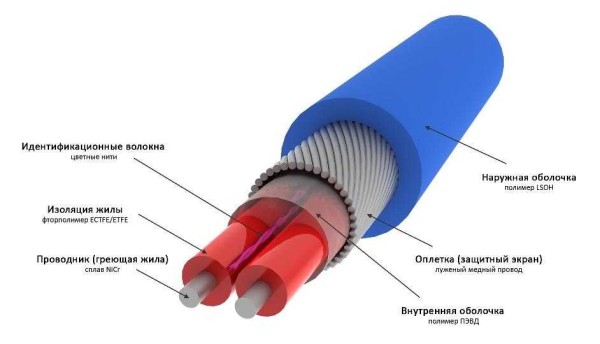
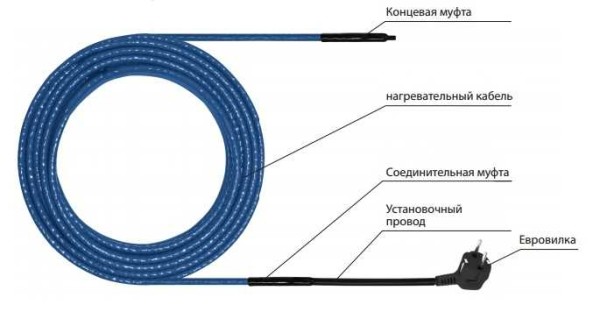
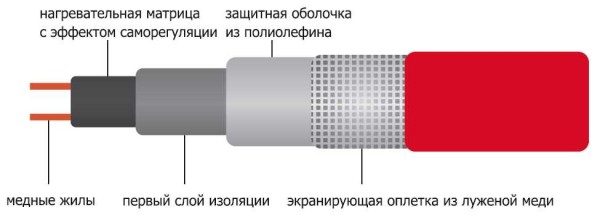
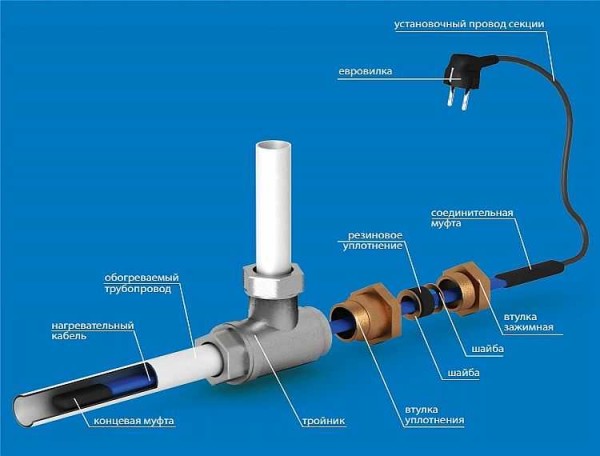
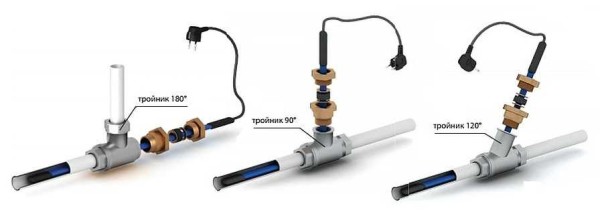
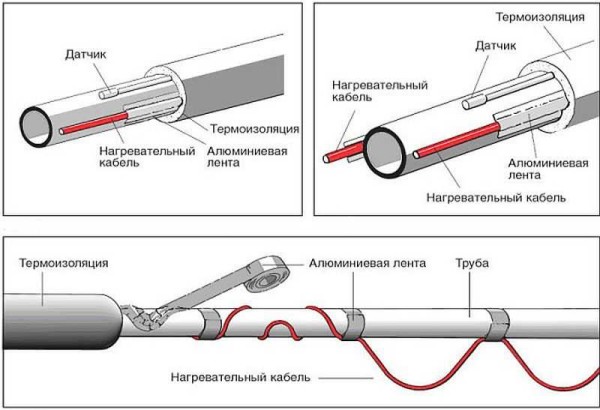
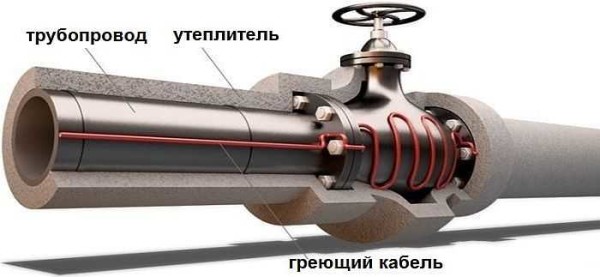
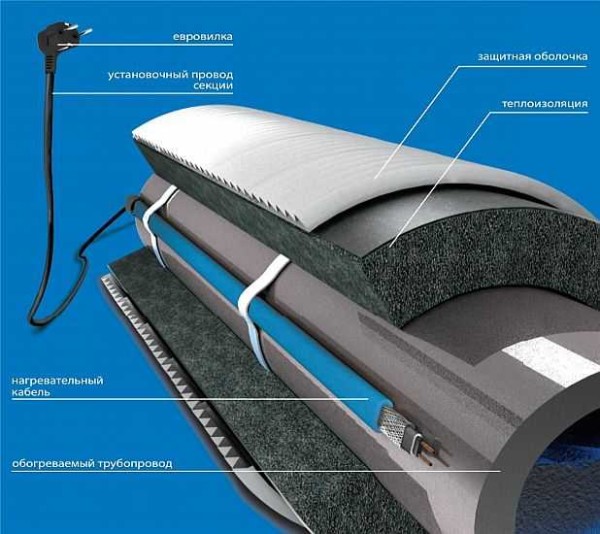
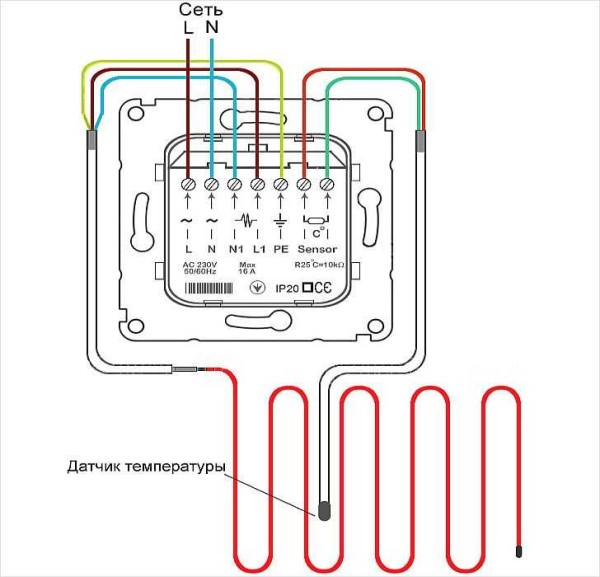
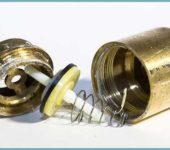
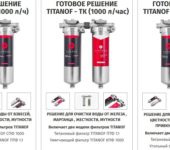

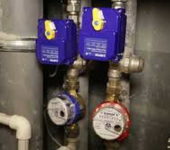






The heating cable for heating pipes is heated by the action of the passing electric current and is the main component of the system designed to prevent the pipes of external communication systems from freezing.
Self-regulating heating (heating) cable for frost protection - allows you to heat the pipe inside and outside, a container with water, heat the pumping station, heat the pipe section at the entrance to the house, taps and valves, etc.
Freeze protection for pipes made of polyethylene (HDPE), metal-plastic, metal.
Konstantin, have a question! There is a pipeline made of PVC pipes with a length of about 500 meters, a nuance - the difference in height between the pump and the receiver is about 90 (!!!) meters, You can give advice on how to protect the pipe from freezing (covered with an insulation jacket), more precisely, how to introduce the heating cable into the HDPE tee to prevent siphoning.? On both sides of the tee, the diameter is 40 mm, on the third, 25 mm.
Tell me I bought a heating tape ENGL-1, it has outputs on both sides, and the connection diagram only with an output on one side, can anyone come across how to connect it?
Guys, explain: in the video, a two-core resistive cable - on one side connects to the cord - and into the outlet, and at the other end - the veins are not connected, but simply drowned out by a thermocased tube. How does the current go? at the other end 2 wires are NOT connected!
You are wrong. At the other end, the conductors are connected using a special connector. That is why they say that it is impossible to cut a two-core heating cable - firstly, the wires are connected, and secondly, the resistance is calculated.
admin, do not enter into confusion, the end is NOT IN THE END OF ANY CASE, the wires are isolated so that there is no contact between themselves, between themselves and the earth-screen, if there is one on the cable.
Good day. I did everything as stated in the video. I plug it in - it doesn't get warm. Cable length - 1 m. What could be wrong?
Did you cut the cable by any chance? Have you tested it after purchase?
Where can you buy a heating cable, internal, and is it sold in lengths of 50 meters or more?
good afternoon, the cable can be used to heat a private house, I mean wrap heating pipes gas is very expensive who used
Sure you may! Much more convenient than gas, there is only one drawback - heating with electricity is 10 times more expensive than gas.